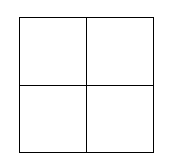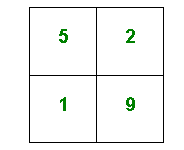Week beginning August 27th – Year 3 to 6
Reach 100
Here is a grid of four “boxes”:

You must choose four different digits from 1−9 and put one in each box. For example:

This gives four two-digit numbers:
- 52 (reading along the 1st row)
- 19 (reading along the 2nd row)
- 51 (reading down the left hand column)
- 29 (reading down the right hand column)
In this case their sum is 151.Try a few examples of your own.
Is there a quick way to tell if the total is going to be even or odd?
Your challenge is to find four different digits that give four two-digit numbers which add to a total of 100. How many ways can you find of doing it?
I started off just trying out a few numbers, like this: (I’ve coloured the boxes so it’s easier to talk about them)

I noticed the blue box was definitely too big. So then I started making it small, like this:

It was still too big. I noticed that blue, red and green should be small because they made the tens place.I got really close:

And,

I tried lots after that but they were still too big or small.
Then I looked at the numbers that made the units, red, green and yellow. I noticed that the yellow was repeated twice. I thought I should find numbers for the units that add up to 10, because 100 has 0 in the units.
I started with 1 in the yellow box. That meant 1 + 1 + ? + ? should give me a multiple of 10. So, I tried 1 + 1 + 3 + 5 = 10
I knew the blue box should be small, so I tried this:

And,

I remembered the yellow box can be big, and the other need to be small, so I tried

My mother asked me if I could find another solution.
I tried 9 and 6 in the yellow box, but they didn’t work. Then I tried 7 in the yellow box:

I also noticed that the red and green box, it didn’t matter which way round they were.

